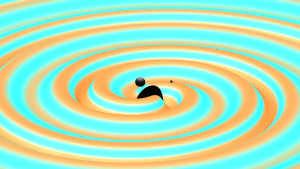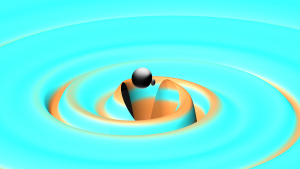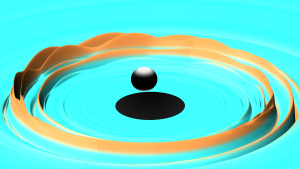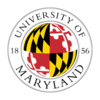Synopsis:
In early 2016, one hundred years after Einstein predicted the existence of gravitational waves on the basis of his theory of General Relativity, LIGO announced the first observation of gravitational waves passing through the Earth emitted by the collision of two black holes one billion four-hundred million light years away.
In this course we will review what gravitational waves are, how they are produced, what are the main astrophysical and cosmological sources and how we model them, using analytical and numerical relativity. We will also review the quest for gravitational waves, which culminated with the recent discovery by LIGO, and discuss how those new astronomical messengers are detected and how they can unveil the properties of the most extreme astrophysical objects in the universe.
 |
 |
 |
Classes schedule:
Classroom: PSC-3150 at UMD
Lecture days: Mondays & Tuesdays: 9:00am – 10:15am (EST)
First day of class: January 30th
Last day of class: May 9th
Instructor contact info:
Name: Alessandra Buonanno
Office room: PSC-3149 @ UMD, office # 1.24 @ AEI
E-mail: buonanno@umd.edu & alessandra.buonanno@aei.mpg.de
Phone: (301) 405 1440 & +49 331 567 7220
Office hours: by appointment
TA contact info:
Name: Noah Sennett
Office room: PSC-3264 @ UMD, office # 0.62 @ AEI
E-mail: noah.sennett@aei.mpg.de & nsennett@umd.edu
Phone: +49 331 567-7183
Office hours: by appointment
Textbooks:
Required textbook: “Gravitational Waves Volume 1: Theory and Experiments”, by Michele Maggiore.
Other useful textbooks:
“Gravitational Wave Physics and Astronomy” by Jolien Creighton & Warren Anderson.
“Gravity” by Eric Poisson & Cliff Will.
“Introduction to General Relativity, Black Holes & Cosmology” by Yvonne Choquet-Bruhat.
Prerequisites:
To follow the classes, students should be already familiar with the material covered in an introductory General Relativity course. It is not necessary to have followed a course in astrophysics and/or cosmology.
Exam:
none
Homeworks policy:
- Late homeworks are accepted only under serious circumstances (to be discussed before due day).
- You are encouraged to discuss homeworks with other students, however the work you turn in should be your own formulation and reflection.
- Use of previous solutions is not allowed (violation of this rule is cause for failure of the course).
- Homework sets must show reasoning leading to the final answers in a clear and readable fashion to obtain credit.
- Please, include your name and write very clearly.
- Please, send the homeworks to the TA by email on the due day before class starts.
- Each student will summarize his/her course project in a 10-page paper and give a 30-minute presentation at the end of the course.
Grading:
The course grade will be based on the homeworks (1/3) and course project (2/3).
Academic Integrity:
The University of Maryland has approved a code of academic integrity available on the web. This code prohibits students from cheating on exams, plagiarizing papers, submitting the same paper for credit in two courses without authorization, buying papers, submitting fraudulent documents, and forging signatures. The university senate requires that students include the following signed statement on each examination or assignment: “I pledge on my honor that i have not given or received any unauthorized assistance on this examination (or assignment).” Compliance with the code is administered by a student honor council, which strives to promote a “community of trust” on the College Park campus. Allegations of academic dishonesty can be reported directly to the honor council (314-9154) by any member of the campus community.
Notes:
PHYS879 is part of the course catalogue of the Physics department of the University of Maryland. UMD students have to register and can take this course for academic credit upon fulfillment of the course requirements. The lecture will be given almost entirely remotely from the Max Planck Institute for Gravitational Physics in Potsdam, Germany, and will be broadcast via videoconferencing to room PSC-3150 at UMD.
Students and researchers in the Potsdam area are invited to audit the classes. No academic credit can be obtained, no official enrollment is necessary. However, if you are interested in auditing this class, you must send an email to andre.schirotzek@aei.mpg.de with the subject line: PHY879. The lectures will take place from 3:00pm – 4:15pm (CET) in the Lecture Hall of the Central Building (Zentralgebäude), see here, Am Mühlenberg 1, Potsdam 14476.
Syllabus:
Note: what is below is a tentative course plan. It will be adjusted during the semester.
The sections in the table below refer to the book by M. Maggiore
| Date (week) | Monday | Tuesday | Reading material |
| Jan 30 & 31 (week 1) |
Overview: A glimpse of gravitational-wave astrophysics | Linearization of Einstein equations, Lorenz gauge, TT gauge [1.1, 1.2] |
Einstein (1916) Einstein (1918) Eddington (1922) Einstein-Rosen (1937) 100 years of GWs First GW detection by LIGO Basic physics of GW150914 Flanagan & Hughes (2005) |
| Feb 6 & 7 (week 2) |
Interaction of GWs with freely falling test particles, key ideas underlying GW detectors [1.3] | Effective EMT of GWs, GW energy and linear-momentum fluxes [1.4] | 1957 Chapel Hill Conference: Pirani & Feynman Ni-Zimmermann (1972) Estabrook-Wahlquist (1975) Rakhmanov (2004) Kennefick (1997) Isaacson (1968) |
| Feb 13 & 14 (week 3) |
Propagation of GWs in curved spacetime, geometric optics approximation, interaction with matter, gravitational lensing, absorption and scattering [1.5] | Astrophysical predictions of compact-object coalescences in light of GW150914 and GW151226 [guest lecturer: Cole Miller] |
Misner-Thorne-Wheeler book (see Ch. 22) Hartle book (see Ch. 11) Wambsganss (1998) Baker-Trodden (2016) Miller (2016) (see Sec. 4) BBH rates from first LIGO detections (see Sec. VI) |
| Feb 20 & 21 (week 4) |
Basics of black hole spacetimes [guest lecturer: Ted Jacobson] |
Leading-order generation of GWs in the slow-motion approximation, quadrupole formula [3.1–3.3] | Hartle book (see Ch. 12 & 15) Penrose (1965) Penrose & Floyd (1971) Jacobson (2012) |
| Feb 27 & 28 (week 5) |
Characteristics of GWs and power radiated from binary systems | GWs from binary systems on inspiraling, circular orbits [4.1.1] | Poisson & Will book (see Ch. 6,7, 11.1, 11.2) Ehlers et al. (1976) |
| Mar 6 & 7 (week 6) |
GWs from binary systems on eccentric orbits [4.1.2 & 4.1.3] | Basics of post-Newtonian theory [5.1] |
Peters & Mathews (1963) Buonanno & Sathyaprakash (2014) Einstein, Infeld & Hoffmann (1938) |
| Mar 13 & 14 (week 7) |
Basics of post-Minkowskian theory [5.3] [guest lecturer: Justin Vines] |
Tidal effects in compact objects [guest lecturer: Tanja Hinderer] |
Misner-Thorne-Wheeler book (see Ch. 36.11) Blanchet Living Review in Relativity (see Secs. A2-A4) Poisson-Will book (see Ch. 1.5, 1.6 & 2.4, 2.5 ) Flanagan-Hinderer (2007) |
| Mar 27 & 28 (week 8) |
Basics of neutron stars, boson stars, etc. [guest lecturer: Tanja Hinderer] |
BH perturbation theory & quasi-normal modes |
LectureNotesTidal LectureNotesPlots Regge-Wheeler (1957) Vishveshwara (1970) Press (1971) Detweiler-Chandrasekhar (1975) Schutz-Will (1985) |
| Apr 3 & 4 (week 9) |
Effective-one-body theory | Effective-one-body theory | Buonanno-Damour (1999) Buonanno-Damour (2000) Buonanno & Sathyaprakash (2014) (see Sec. 6.2.3) Damour (2012) |
| Apr 10 & 11 (week 10) |
Numerical Relativity [guest lecturer: Ian Hinder] |
Numerical Relativity [guest lecturer: Ian Hinder] |
Alcubierre book (see Ch. 2-6) SlidesNR |
| Apr 17* & 18 (week 11) |
see note below | Analytical/numerical relativity templates for searches of GWs from compact-object binaries [7.2, 9.2.3] |
SlidesEOB-NRAR Finn & Chernoff (1993) Buonanno (2007) (see Sec. 6.4) |
| Apr 24 & 25 (week 12) |
Data analysis tools for modeled searches of GWs from compact-object binaries [7.1, 7.3, 7.7] |
Data analysis tools for parameter-estimation of GWs from compact-object binaries [7.4] |
SlidesDA-PE |
| May 1 & 2 (week 13) |
Minimal assumption searches of short-duration GW signals (bursts) [7.5] [guest lecturer: Peter Shawhan] |
Inferring properties/tests of GR with GW150914 & GW151226 | GW150914-minimal-assumption-search GW150914-properties GW150914-tests-of-GR |
| May 8 & 9 (week 14) |
GWs from early Universe: phase transitions, cosmic/fundamental strings/phenomenological bounds | GWs from early Universe: cosmic inflation | SlidesPrimordialGWs Maggiore (2000) (see Secs. 2, 7-10) LIGO-O1-GWStochasticBackground Siemens et al. 2007 Caprini et al. 2016 |
*: April 17 class will not take place because it is national holiday in Germany and the AEI is closed. We’ll recuperate the class by adding 15 min to the classes of Apr 24, 25, May 2, 8 & 9.
Assignments:
| Assigned date/due date | Homeworks | Solutions |
| Jan 30/Feb 13 | ||
| Feb 13/Feb 27 | ||
| Feb 27/Mar 13 | ||
| March 13/Apr 7 | ||
| April 10/May 1 | ||
Course projects:
| Student name | Project title |
| Batoul Banihashemi | Neutron-star current-quadrupole effects in gravitational-wave signals |
| Roberto Cotesta | Effective-one-body multipolar waveforms for spinning, binary black holes |
| Nishant Gupta | Laws of neutron-star dynamics versus laws of black-hole dynamics |
| Mohammed Khalil | Post-Newtonian expansion and effective-one-body theory for charged bodies |
| Israel Martinez | Exploring the potential for join gravitational waves and gamma-ray bursts observations in the coming years |
| Shwan Rosofsky | Exploring numerical-relativity simulations of neutron-star spacetimes |
| Donggeun Tak | Revisit electromagnetic counterparts of GW150914 |

